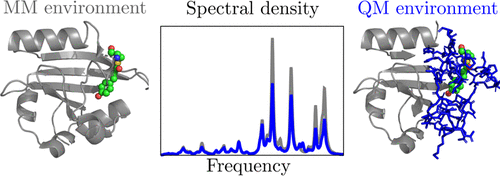当前位置:
X-MOL 学术
›
J. Phys. Chem. B
›
论文详情
Our official English website, www.x-mol.net, welcomes your feedback! (Note: you will need to create a separate account there.)
Influence of Electronic Polarization on the Spectral Density.
The Journal of Physical Chemistry B ( IF 3.3 ) Pub Date : 2019-12-27 , DOI: 10.1021/acs.jpcb.9b10250 Tim J Zuehlsdorff 1 , Hanbo Hong 1 , Liang Shi 1 , Christine M Isborn 1
The Journal of Physical Chemistry B ( IF 3.3 ) Pub Date : 2019-12-27 , DOI: 10.1021/acs.jpcb.9b10250 Tim J Zuehlsdorff 1 , Hanbo Hong 1 , Liang Shi 1 , Christine M Isborn 1
Affiliation

|
Accurate spectral densities are necessary for computing realistic exciton dynamics and nonlinear optical spectra of chromophores in condensed-phase environments, including multichromophore pigment-protein systems. However, due to the significant computational cost of computing spectral densities from first principles, requiring many thousands of excited-state calculations, most simulations of realistic systems rely on treating the environment as fixed-point charges. Here, using a number of representative systems ranging from solvated chromophores to the photoactive yellow protein (PYP), we demonstrate that the quantum mechanical (QM) electronic polarization of the environment is key to obtaining accurate spectral densities and line shapes within the cumulant framework. We show that the QM environment can enhance or depress the coupling of fast chromophore degrees of freedom to the energy gap, altering the electronic-vibrational coupling and the resulting vibronic progressions in the absorption spectrum. In analyzing the physical origin of peaks in the spectral density, we identify vibrational modes that couple the electron and the hole as being particularly sensitive to the QM screening of the environment. For PYP, we reveal the need for careful determination of the appropriate QM region to obtain reliable spectral densities. Our results indicate that the QM polarization of the environment can be crucial not just for excitation energies but also for electronic-vibrational coupling in complex systems with implications for the correct modeling of linear and nonlinear optical spectroscopy in the condensed phase as well as energy transfer in pigment-protein complexes.
中文翻译:

电子极化对光谱密度的影响。
精确的光谱密度对于计算凝聚相环境(包括多发色团色素-蛋白质系统)中发色团的现实激子动力学和非线性光谱是必不可少的。但是,由于从第一性原理计算光谱密度的计算成本很高,需要成千上万的激发态计算,因此,现实系统的大多数模拟都依赖于将环境视为定点电荷。在这里,使用从溶剂化生色团到光敏黄色蛋白(PYP)的许多代表性系统,我们证明了环境的量子力学(QM)电子极化是在累积量框架内获得准确的光谱密度和线形的关键。我们表明,QM环境可以增强或抑制快速生色团自由度与能隙的耦合,从而改变电子振动耦合以及由此产生的吸收光谱中的电子振动进程。在分析光谱密度峰值的物理起源时,我们确定了耦合电子和空穴的振动模式对环境的QM筛选特别敏感。对于PYP,我们发现需要仔细确定适当的QM区域以获得可靠的光谱密度。
更新日期:2020-01-14
中文翻译:

电子极化对光谱密度的影响。
精确的光谱密度对于计算凝聚相环境(包括多发色团色素-蛋白质系统)中发色团的现实激子动力学和非线性光谱是必不可少的。但是,由于从第一性原理计算光谱密度的计算成本很高,需要成千上万的激发态计算,因此,现实系统的大多数模拟都依赖于将环境视为定点电荷。在这里,使用从溶剂化生色团到光敏黄色蛋白(PYP)的许多代表性系统,我们证明了环境的量子力学(QM)电子极化是在累积量框架内获得准确的光谱密度和线形的关键。我们表明,QM环境可以增强或抑制快速生色团自由度与能隙的耦合,从而改变电子振动耦合以及由此产生的吸收光谱中的电子振动进程。在分析光谱密度峰值的物理起源时,我们确定了耦合电子和空穴的振动模式对环境的QM筛选特别敏感。对于PYP,我们发现需要仔细确定适当的QM区域以获得可靠的光谱密度。


























 京公网安备 11010802027423号
京公网安备 11010802027423号